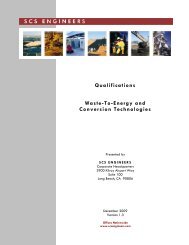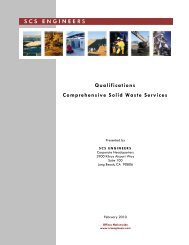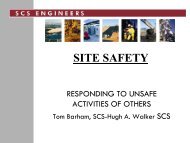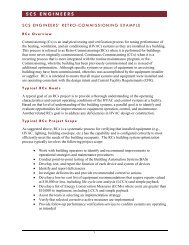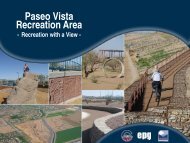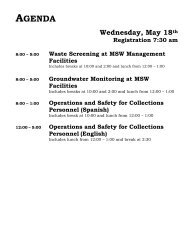NAWTEC18-3501 - SCS Engineers
NAWTEC18-3501 - SCS Engineers
NAWTEC18-3501 - SCS Engineers
Create successful ePaper yourself
Turn your PDF publications into a flip-book with our unique Google optimized e-Paper software.
Proceedings of the 18th Annual North American Waste-to-Energy Conference<br />
<strong>NAWTEC18</strong><br />
May 11-13, 2010, Orlando, Florida, USA<br />
<strong>NAWTEC18</strong>-<strong>3501</strong><br />
DEVELOPING A 21 ST CENTURY ENERGY FROM WASTE FACILITY IN AMERICAN SAMOA<br />
Marc J. Rogoff, PhD<br />
<strong>SCS</strong> <strong>Engineers</strong><br />
Tampa, Florida, USA<br />
Michael Keyser<br />
American Samoa Power Authority<br />
Pago Pago, American Samoa<br />
Michelle Mullet Nicholls<br />
<strong>SCS</strong> <strong>Engineers</strong><br />
Long Beach, California, USA<br />
Patero Lafaele<br />
American Samoa Power Authority<br />
Pago Pago, American Samoa<br />
ABSTRACT<br />
American Samoa is an unincorporated territory of the U.S. The<br />
largest and most populated island in American Samoa is<br />
Tutuila, which is located in the territory’s historic capitol of<br />
Pago Pago. The territory is home to the world’s largest tuna<br />
cannery. Population growth has been dramatic and the island’s<br />
energy costs have increased substantially in recent years. The<br />
American Samoa Power Authority (ASPA) is responsible for<br />
solid waste collection and disposal in the territory with<br />
landfilling being the primary mode of waste disposal. However,<br />
limited available land on the main island due to volcanic<br />
topography limits the long-term use of landfilling as the<br />
island’s sole waste management tool. The relative isolated<br />
location of American Samoa and the instability of world oil<br />
markets have prompted ASPA to look at more environmentally<br />
and economically sustainable means of solid waste<br />
management. As an outgrowth of its research, ASPA submitted<br />
and received a technical assistance grant from the U.s.<br />
Department of the Interior to conduct an extensive waste<br />
composition study and EfW feasibility study to examine the<br />
advantages and disadvantages of efW for American Samoa.<br />
The results of these studies have been completed by <strong>SCS</strong> on<br />
behalf of ASPA, which is currently taking steps to permit and<br />
procure a 2.0 megawatt, modular efW facility that will go<br />
online in 2012 as part of a public private partnership. The<br />
lessons learned by SCs and ASPA during the course of the<br />
investigations are illustrative of the types of long-term, waste<br />
management and energy decision-making that many small<br />
communities will have to undertake to attain viable and<br />
sustainable alternatives.<br />
INTRODUCTION<br />
American Samoa is a territory of the U.S. and part of the<br />
Samoan archipelago, a group of volcanic islands in the South<br />
Pacific. The main islands are Aunu’u, Ofu, Olosega, Ta’u, and<br />
Tutuila, which are located approximately 2,300 miles<br />
southwest of Hawaii and about 2,700 miles northeast of<br />
Australia (Figure 1). The largest and most populated island in<br />
American Samoa is Tutuila, on which are located the territory’s<br />
historic capital (Pago Pago), the seat of its legislature,<br />
judiciary, and the office of the Governor. This article addresses<br />
solid waste management issues on this main island.<br />
Figure 1. Location Map of<br />
American Samoa<br />
The American Samoa Power Authority (ASPA) is the<br />
territory’s publicly-run municipal utility that provides electric,<br />
water, wastewater, and solid waste services to the residents of<br />
American Samoa. Under its enabling legislation, ASPA is<br />
mandated to operate self-sufficiently at full-cost recovery.<br />
1 Copyright © 2010 by ASME
ASPA possesses the ability and the mandate to charge fees in<br />
return for its services. This power to assess rates, charges and<br />
fees to its customers provides ASPA with a mechanism to fund<br />
solid waste management projects, which could not otherwise be<br />
funded under a tax subsidized program.<br />
ASPA also receives an annual capital improvement grant from<br />
the U.S. Department of Interior (DOI). Grant funds are used to<br />
purchase new and replacement equipment such as bins,<br />
containers, collection trucks, and equipment for ASPA’s Futiga<br />
Landfill and scrap metal yard.<br />
In 2009, ASPA applied DOI funds to reestablish control of<br />
solid waste collection services from private haulers, which<br />
resulted in a substantial drop in SW expenses as projected on<br />
several cost benefit analysis conducted in the past.<br />
Furthermore, services reached more consumers compared to<br />
when it was under the private haulers.<br />
In 2008, ASPA was awarded a technical assistance grant from<br />
DOI to conduct a waste composition study to quantify and<br />
characterize the composition of waste disposed of at the Futiga<br />
Landfill. The overall objectives of the project were to develop<br />
reliable estimates of the quantity and composition of wastes<br />
disposed by key generator groups. The data were then used to<br />
identify potential energy-from-waste (EfW) options for<br />
American Samoa, including the types of processing facilities<br />
potentially suitable for island conditions, facility costs, and<br />
energy generation. Current power costs for ASPA are in the<br />
range of $0.26 per kilowatt-hour, more than triple that of a<br />
typical city on the mainland USA.<br />
PAST SOLID WASTE PLANNING<br />
Over the past 20 years, a number of solid waste consultants<br />
have been engaged by the territorial government, EPA and DOI<br />
to study solid waste management conditions on the island and<br />
make recommendations for improvements. These studies<br />
provided conceptual evaluations of possible changes to the<br />
solid waste system in American Samoa with respect to<br />
collection, transfer, recycling, volume reduction via<br />
incineration, and disposal. The territorial government, and,<br />
later ASPA, has implemented some of these projects as part of<br />
the DOI grant process, but the territory as a whole, up until the<br />
present time, has not progressed much beyond basic landfilling<br />
of solid waste and recycling of some scrap metals. The<br />
objective of this study was to enable ASPA to extend and<br />
maximize capacity and extend the life of the Futiga Landfill<br />
due to volumetric reductions obtained by waste through<br />
incineration.<br />
With respect to waste incineration, all of the former studies<br />
came to the same basic conclusion. That is, waste incineration<br />
with energy recovery appeared promising for the main island,<br />
given ASPA’s high costs to produce power from conventional<br />
technologies. These costs have escalated dramatically in recent<br />
years due to reliance on increasingly expensive, imported diesel<br />
fuel. Recommendations included the construction and<br />
operation of a dual, modular solid waste incineration system,<br />
either on a single site or on two sites optimally spaced across<br />
the main island.<br />
HOW MUCH WASTE IS AVAILABLE FOR EFW<br />
The <strong>SCS</strong> study team conducted a waste volume and<br />
composition assessment program at the Futiga Landfill over a<br />
period of several weeks. Data from this program were<br />
extrapolated to forecast the amount of waste delivered to the<br />
island’s only disposal site each year. Since there are no<br />
working scales installed at that time at the landfill all haulers,<br />
residents, and businesses were asked to weigh in and out at a<br />
weigh scale at the scrap yard during the term of this study. The<br />
raw data were corrected for observed anomalies then converted<br />
to approximate the municipal solid waste (MSW) stream that<br />
would be typically disposed of at the landfill, and thus<br />
available for feedstock to a future EfW plant. Typical EfW<br />
facilities are run continuously on a 24-hour, seven day a week<br />
operational pattern. Thus, to estimate the island’s waste stream<br />
available for this proposed facility, these data were converted<br />
using to a seven-day average for plant sizing purposes. As<br />
shown in Table 1, the weigh data appear to show that<br />
approximately 62 tons per day of MSW, tires, and waste oil<br />
would be initially available as feedstock/fuel for the plant.<br />
TABLE 1 EFW PLANT SIZING ASSUMPTIONS<br />
Assumptions<br />
Waste/<br />
Population<br />
Growth<br />
(1.5%/Year)<br />
WTE<br />
Downtime<br />
@ 10%<br />
WTE<br />
Downtime<br />
@15%<br />
Year<br />
0 1 2 3 4 5 6 7 8 9 10<br />
62 63 64 65 66 67 68 69 70 71 72<br />
69 70 71 72 73 74 75 76 78 79 80<br />
73 74 75 76 77 79 80 81 82 83 85<br />
CONDUCTING AN ISLAND WASTE COMPOSITION<br />
STUDY<br />
The waste composition sampling was critical to help EfW plant<br />
designers to obtain a clear picture on the heating value to the<br />
incoming waste stream. To accomplish this objective, data<br />
gathered were obtained during two week-long waste sampling<br />
seasons (wet and dry), was used to provide a more complete<br />
picture of waste composition and heating value of the waste<br />
stream.<br />
The sorting crew hand-sorted approximately six to eight<br />
samples daily for each weeks’ sampling program (Figure 2).<br />
2 Copyright © 2010 by ASME
Samples were manually sorted into 53 material categories, and<br />
the material in each category was weighed. The largest<br />
component of the overall waste stream is paper and related<br />
material, as shown in Figure 3. Organics and metals comprised<br />
the next largest components, at 20% and 18%, respectively.<br />
The remaining waste types together accounted for about 46%<br />
of the landfill’s waste stream.<br />
production of 29 megawatts Given the limited flat land<br />
available for construction (due to the island’s volcanic terrain),<br />
it appears that the best site for this facility would be a three acre<br />
parcel adjacent to ASPA’s existing Tafuna Power Plant, near<br />
the island’s airport and only industrial park. The site has<br />
access to electric power, the island’s grid, potable water and<br />
wastewater services.<br />
As part of the feasibility analysis, a Pro Forma Economic<br />
Model was developed to explore the projected costs and<br />
revenues of a EfW facility. These results indicate that the<br />
projected tipping fees, if any, revenues from energy sales and<br />
carbon credits should be adequate to pay for the facility’s<br />
operating and maintenance expenses and debt service/loan<br />
payments. Further scenarios examined the impact of a 30%<br />
capital cost savings potentially available to the project under<br />
the recently enacted U.S. Department of the Treasury grant<br />
program, pursuant to the American Recovery and Reinvestment<br />
Act of 2009.<br />
Figure 2. Photo of Waste Collection Sort<br />
Figure 3. Average Waste Composition for<br />
Composite Sampling Program<br />
Since the sale of energy plays an important role in the<br />
economic feasibility of an EfW project, the heating value of the<br />
waste stream is a key design factor. The heating value of solid<br />
waste is typically measured by Btus per pound of MSW in the<br />
USA, and is well documented. Using published Btu values of<br />
waste, combined with the waste composition data and moisture<br />
content obtained from this study, the team calculated the<br />
projected energy content of the overall waste stream. Waste oil<br />
and tires are potential additional waste-sourced fuels available<br />
in the territory.<br />
EFW FEASIBILITY<br />
Results of this initial feasibility study indicate that EfW is a<br />
viable solid waste management alternative for American<br />
Samoa. Given current waste composition and generation<br />
trends, a modular-type EfW system, somewhere in the range of<br />
70 to 85 tons per day capacity, would provide roughly 2.0<br />
megawatts of electrical power for the territory’s total energy<br />
ASPA’S NEXT STEPS<br />
The implementation of an EfW facility would require a<br />
significant capital investment by ASPA for planning,<br />
engineering, permitting, equipment, and construction, perhaps<br />
constituting one of the largest public works/utility projects in<br />
the territory. Nevertheless, this EfW project would result in an<br />
improved, long-term solid waste management solution for<br />
American Samoa, as well as providing much-needed base load<br />
power resources for electric generation.<br />
At the outset of the overall program, ASPA appointed an<br />
internal Project Team to help guide the project through all of<br />
the critical steps. This Team consists of government officials<br />
and outside consultants, representing engineering and<br />
environmental, management, financial, public involvement, and<br />
legal expertise.<br />
Initial efforts have begun to craft an inclusive Request for<br />
Proposal (RFP), which will include technical specifications for<br />
the project, define the roles and responsibilities for the parties<br />
(vendor and ASPA), basic contractual requirements, a<br />
financing plan, and the method that will be used by ASPA to<br />
evaluate vendor proposals. In concert with the development of<br />
the RFP, ASPA has engaged the services of an experienced<br />
permitting professional to initiate the air quality permit<br />
application for the EfW facility with the U.S. EPA., the<br />
permitting agency for this matter<br />
At the same time, ASPA has begun an analysis of available<br />
land at the current landfill for design, permitting, and<br />
construction of a lined cell for disposal of ash residues from the<br />
proposed EfW plant. While recycling of the plant’s ash stream<br />
is possible over the long-term, the prudent course of action is to<br />
design and construct a landfill cell for ash residues.<br />
3 Copyright © 2010 by ASME
Lastly, in concert with the procurement and permitting steps,<br />
ASPA has undertaken a proactive public involvement and<br />
outreach program to inform territory citizens about the<br />
project’s aims to provide for long-term solutions for solid<br />
waste management issues, while providing an alternative,<br />
renewable energy supply for the territory. This public outreach<br />
program will involve periodic media information releases on<br />
the project, development of a project brochure, and ASPA staff<br />
interviews. This approach will assure a large majority of the<br />
public that the project has been prudently developed.<br />
REFERENCES<br />
1. <strong>SCS</strong> <strong>Engineers</strong>. Waste Characterization and Waste-to-<br />
Energy Facility Study, American Samoa Power Authority,<br />
2009.<br />
2. Rogoff, Marc J. How to Implement Waste-to-Energy<br />
Projects, Noyes Publications: Park Ridge, NJ, 1987.<br />
TABLE 2 PROJECTED BTU VALUE OF WASTE COMPONENTS<br />
Material Type<br />
Portion of<br />
Overall<br />
Wastestream<br />
Inherent<br />
Energy<br />
(Btu/lb)<br />
Moisture<br />
Content<br />
Revised<br />
Energy<br />
(Btu/lb)<br />
Total Energy<br />
Contribution<br />
(Btu/lb)<br />
Food 3.5% 2,000 92.5% 151 5<br />
Paper (without cardboard) 6.7% 7,200 23.5% 5,508 371<br />
Cardboard 17.6% 7,000 52.5% 3,325 586<br />
Plastics 11.8% 14,000 23.0% 10,780 1,272<br />
Textiles 3.9% 7,500 23.5% 5,738 221<br />
Rubber 0.0% 10,000 10,000 5<br />
Leather 0.0% 7,500 7,500 0<br />
Garden trimmings 10.6% 2,800 66.5% 938 99<br />
Wood (clean, painted, treated) 1.2% 8,000 8,000 93<br />
Glass 3.2% 60 60 2<br />
Tin cans 4.7% 300 300 14<br />
Nonferrous metals 1.3% 0 0 0<br />
Ferrous metals 0.5% 300 300 1<br />
Dirt, ashes, brick, etc. 0.0% 3,000 3,000 1<br />
Municipal solid wastes 15.0% 4,500 70.0% 1,350 202<br />
Waste Oil 2.2% 21,000 92.5% 21,000 472<br />
Tires 5.3% 13,500 23.5% 13,500 713<br />
Total 87.4% 4,058<br />
4 Copyright © 2010 by ASME



